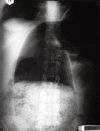Colonic duplication in an adult who presented with chronic constipation attributed to hypothyroidism
- PMID: 18203304
- PMCID: PMC2681163
- DOI: 10.3748/wjg.14.644
Colonic duplication in an adult who presented with chronic constipation attributed to hypothyroidism
Abstract
Gastrointestinal duplications are an uncommon congenital abnormality that manifest before the age of two in 80% of cases. Ileal duplication is the most common while colonic duplication, either cystic or tubular, occurs in 10%-15% of cases and remains asymptomatic and undiagnosed in most cases. Mostly occurring in pediatric patients, colonic duplication is encountered in adults in only a few cases. The most common clinical manifestations are abdominal pain and intestinal obstruction. Rarely, duplications present with signs of acute abdomen or acute bleeding. This study reports a case of colonic duplication in an adult who presented with chronic constipation. Complete diagnostic workup was made on several occasions during the previous eight year period, but no pathology was found and chronic constipation was attributed to hypothyroidism caused by long standing Hashimoto thyroiditis. Multislice CT, performed because of abdominal distension, defined colonic pathology but the definite diagnosis of duplication of the transversal colon was made at operation. The cystic duplication and the adjacent part of the ascending and transversal colon were excised en-block. This study implies that colonic duplication, though uncommon, should be included in the differential diagnosis of chronic constipation even when precipitating factors for constipation, such as hypothyroidism are present.
Figures




Similar articles
-
Colonic duplication presenting as a huge abdominal mass in an adult female.Int J Colorectal Dis. 2019 Nov;34(11):1995-1998. doi: 10.1007/s00384-019-03409-9. Epub 2019 Oct 23. Int J Colorectal Dis. 2019. PMID: 31642971
-
Colonic duplication in adults: report of two cases presenting with rectal bleeding.World J Gastroenterol. 2005 Aug 28;11(32):5072-4. doi: 10.3748/wjg.v11.i32.5072. World J Gastroenterol. 2005. PMID: 16124070 Free PMC article.
-
Transverse colon duplication with chronic constipation in adult.BMJ Case Rep. 2019 Apr 5;12(4):e226450. doi: 10.1136/bcr-2018-226450. BMJ Case Rep. 2019. PMID: 30954954 Free PMC article.
-
[Intestinal duplication in the adult. A case report of colonic duplication and a review of the literature].Chir Ital. 2002 Sep-Oct;54(5):721-8. Chir Ital. 2002. PMID: 12469471 Review. Italian.
-
A rare case of duplication of the descending colon in a pregnant woman: case report and literature review.Acta Biomed. 2023 Jan 31;94(S1):e2023042. doi: 10.23750/abm.v94iS1.12169. Acta Biomed. 2023. PMID: 36718780 Review.
Cited by
-
Robotic Sigmoidectomy of a Rare Instance of Sigmoid Colon Duplication in an Elderly Patient: A Case Report.Cureus. 2023 Aug 27;15(8):e44208. doi: 10.7759/cureus.44208. eCollection 2023 Aug. Cureus. 2023. PMID: 37767241 Free PMC article.
-
A unique case of complete tubular colonic duplication with normal anus accompanied by vestibular fistula in a 12 years _ old _ girl - A case report.Int J Surg Case Rep. 2023 Jul;108:108405. doi: 10.1016/j.ijscr.2023.108405. Epub 2023 Jun 17. Int J Surg Case Rep. 2023. PMID: 37352770 Free PMC article.
-
Colonic duplication presenting as a huge abdominal mass in an adult female.Int J Colorectal Dis. 2019 Nov;34(11):1995-1998. doi: 10.1007/s00384-019-03409-9. Epub 2019 Oct 23. Int J Colorectal Dis. 2019. PMID: 31642971
-
Feline abdominal ultrasonography: What's normal? What's abnormal? The diseased gastrointestinal tract.J Feline Med Surg. 2019 Nov;21(11):1047-1060. doi: 10.1177/1098612X19880434. J Feline Med Surg. 2019. PMID: 31648606 Free PMC article.
-
Adenocarcinoma originating from a colonic duplication cyst: A case report.World J Gastrointest Surg. 2025 Apr 27;17(4):103136. doi: 10.4240/wjgs.v17.i4.103136. World J Gastrointest Surg. 2025. PMID: 40291868 Free PMC article.
References
-
- Ladd WE. Duplications of the alimentary tract. South Med J. 1937;30:363–371.
-
- Macpherson RI. Gastrointestinal tract duplications: clinical, pathologic, etiologic, and radiologic considerations. Radiographics. 1993;13:1063–1080. - PubMed
-
- Puligandla PS, Nguyen LT, St-Vil D, Flageole H, Bensoussan AL, Nguyen VH, Laberge JM. Gastrointestinal duplications. J Pediatr Surg. 2003;38:740–744. - PubMed
-
- Cavar S, Bogovic M, Luetic T, Antabak A, Batinica S. Intestinal duplications--experience in 6 cases. Eur Surg Res. 2006;38:329–332. - PubMed
Publication types
MeSH terms
LinkOut - more resources
Full Text Sources
Medical
Research Materials

